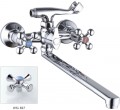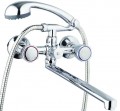Handle design
The shape of the handles provided in the design of the tap of the corresponding type — usually two-valve (see "Tap type").
This feature mainly affects the appearance of the structure, but different design options also have practical application features:
—
Cross. Gates in the form of classic four-pointed crosses are the most popular design nowadays. It is great for retro-style taps, but can also be used in more modern designs. However, the main advantage of this option is the presence of reliable stops under the fingers, which makes cross handles very convenient to use. This is primarily due to their popularity. The disadvantages of "crosses" include some difficulty in cleaning due to the abundance of protruding parts; however, to facilitate this task, the bars of such a handle can be made removable.
—
Round. This category includes both strictly round valves and parts that have small protrusions or recesses for a more secure grip (and in the first case, for the same purpose, a special notch may be provided around the circumference of the valve). Anyway, the main advantages of round products are a neat appearance and maximum ease of cleaning. On the other hand, this shape is the least secure to hold, requires a tight grip, and is most likely to slip the handle in the hand when turning. However, most often modern taps do not require much effort, and this moment is not particula
...rly critical.
— Triangular. Handles with three pronounced cutouts or protrusions. The specific shape may be different: some models are very close to round, others have the shape of triangles, others differ from cross handles only in the number of rays. The stronger the shape of such a handle differs from a circle, the more reliable it is to hold. On the other hand, sometimes the best option in terms of design are more rounded models.
— Square. Handles with four pronounced cutouts or projections. Note that a strictly square shape is rare, mainly in expensive designer taps (in fact, for design reasons, it is used in them). Much more popular are "square" handles in the form of a kind of star with four rays/petals. This is a kind of compromise between round and cross-shaped: the handle turns out to be more secure in holding than round, and more convenient to clean than the "cross".
— Polygonal. "Handles with corners", not related to the triangular or squared described above. The most popular type of such parts is round rotary knobs with a set of protrusions — “rays” (from 5 or more) for reliable retention; however, there are also more specific options — for example, an oblate polygon that resembles a figure eight.
— Oval. Handles having an oval or close to it shape (for example, a rectangle with rounded corners). One of the options for this design is bath and shower taps, in which the body has a horizontal layout and elongated proportions, and the handles are located on the side ends of the body and are actually its continuation. Another option is a round handle shape with a flat cut on one edge for added retention. There are other, more specific options. However, anyway, "ovals" are rarely used, mainly among designer-level taps, and the role of this form is more aesthetic than practical.Jet depth
Distance from the fixing point (for vertically mounted taps) or from the centre of the mounting hole (for horizontally mounted taps) to the middle of the spout. It is a characteristic that determines the "reach zone" of the tap.
Shower set
In most cases, this is not one accessory, but a whole set that allows you to use the tap for showering. A mandatory element of the shower set is a
shower head, in most cases it is supplemented with its own hose. In addition, the design may provide a mount for a watering can — on the wall or directly on the tap's body (for the second option, see below). But the purpose and functionality of the shower set may be different, depending on the specialization of the tap itself (see "Suitable for"). So, in bath and shower models, water can be supplied either through a spout or through a shower set, and an appropriate switch is provided for selection (sometimes automatic, see below). Shower-only taps do not have this switch. In models for washbasins, the shower set is designed for the so-called hygienic shower — washing certain parts of the body (primarily the groin area, etc.); the watering can for such a shower is small in size and is equipped with its own button that turns the water on and off. There are even kitchen taps with this function — the shower performs the same function as the pull-out spout. And the number of modes may not be limited to one.
Several hand shower modes allow you to get a shower water jet of your favour — from classic small streams to one continuous stream, with all sorts of variations. The more settings provided, the wider the choice.
Material
—
Brass. Alloy based on copper and zinc; at a relatively low price, it has good strength and corrosion resistance, due to which it has become widespread.
— Silumin. An alloy based on a combination of aluminium and silicon; it has good hardness and oxidation resistance, but it is rather brittle, and therefore it is used mainly in inexpensive models.
— Stainless steel. The most common material for inexpensive models. Steel is inexpensive and at the same time has high strength. Its disadvantage is a certain tendency to corrosion (especially with processing defects, even small ones), which practically does not affect everyday use, but can affect the durability of the tap.
— Zinc. Zinc products are similar in their main properties to the silumin products described above: on the one hand, they are inexpensive, on the other hand, they are quite fragile and not particularly durable. In addition, zinc is believed to be prone to corrosion, which can eventually degrade the properties of the water coming from such a tap and make this material unsuitable for kitchen use. Therefore, zinc bodies are not common, mainly among inexpensive bath and shower taps.
— Plastic. The simplest material used in the manufacture of taps. Due to its weak strength, it is not durable, but it does not rust. It is appropriate to use for sinks of rare use — for example, for a country house.
Tap height
The height of the tap, measured from its base or lowest point to the highest point of the spout. The height of the spout partly determines the installation possibilities — in fact, this is the minimum vertical free space that is required for the tap. In addition, in models with horizontal installation (see "Type of installation"), the spout height is related to the jet height (see below).

